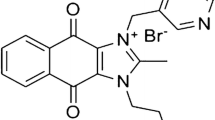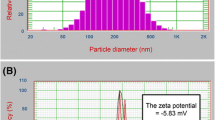Abstract
Purpose. Immuno-enzymosomes are tumor-specific immunoliposomes bearing enzymes on their surface. These enzymes are capable of converting relatively nontoxic prodrugs into active cytostatic agents. The enzyme β-glucuronidase (GUS)4 was coupled to the external surface of immunoliposomes directed against ovarian carcinoma cells. This study aimed at optimization of the prodrug-activating capacity of these immuno-enzymosomes by increasing the enzyme density on the immunoliposomal surface.
Methods. To achieve coupling of GUS to the liposomes, introduction of extra thiol groups was required. Two thiolating agents were examined: iminothiolane and SATA.
Results. When iminothiolane was used, aggregation of enzymosomes was observed above enzyme densities of 10 µg GUS/µmol lipid (TL). An increased electrostatic repulsion of the enzymosomes, created by inclusion of additional negatively charged lipids and by lowering the ionic strength of the external aqueous medium resulted in enzyme densities ≥ 20 µg GUS/µmol TL without aggregation. Utilizing SATA, ≥ 30 µg GUS/µmol TL could be coupled without aggregation, even at physiological ionic strength. It was shown that the enzyme density on immuno-enzymosomes, and thus on the tumor cell surface, strongly influences the antitumor effect of the prodrug daunorubicin-glucuronide against in vitro cultured ovarian cancer cells. The antitumor effect of immuno-enzymosomes with enzyme densities of about 20 µg GUS/µmol TL was similar to that of the parent drug daunorubicin.
Conclusions. SATA-mediated thiolation of GUS-molecules enabled the preparation of immuno-enzymosomes with high enzyme densities while avoiding spontaneous aggregation. In vitro antitumor activity experiments showed that the improved immuno-enzymosome system is able to completely convert the prodrug daunorubicin-glucuronide into its parent compound.
Similar content being viewed by others
REFERENCES
P. D. Senter, P. M. Wallace, H. P. Svensson, V. M. Vrudhula, D. E. Kerr, I. Hellström and K. E. Hellström. Generation of cytotoxic agents by targeted enzymes. Bioconj. Chem. 4:3–9 (1993).
M. P. Deonarain and A. A. Epenetos. Targeting enzymes for cancer therapy: old enzymes in new roles. Br. J. Cancer 70:786–794 (1994).
K. D. Bagshawe, C. J. Springer, F. Searle, P. Antoniw, S. K. Sharma, R. G. Melton and R. F. Sherwood. A cytotoxic agent can be generated selectively at cancer sites. Br. J. Cancer 58:700–703 (1988).
H. J. Haisma, E. Boven, M. van Muijen, J. de Jong, W. J. F. van der Vijgh and H. M. Pinedo. A monoclonal antibody-β-glucuronidase conjugate as activator of the prodrug epirubicin-glucuronide for specific treatment of cancer. Br. J. Cancer 66:474–478 (1992).
K. D. Bagshawe, S. K. Sharma, C. J. Springer and P. Antoniw. Antibody directed enzyme prodrug therapy: a pilot-scale clinical trial. Tumor Targeting 1:17–29 (1995).
M. H. Vingerhoeds, H. J. Haisma, M. van Muijen, R. B. J. van de Rijt, D. J. A. Crommelin and G. Storm. A new application for liposomes in cancer therapy: immunoliposomes bearing enzymes (immuno-enzymosomes) for site-specific activation of prodrugs. FEBS Lett. 336:485–490 (1993).
U. K. Nässander, P. A. Steerenberg, W. H. De Jong, W. O. W. M. van Overveld, C. M. E. te Boekhorst, L. G. Poels, P. H. K. Jap and G. Storm. Design of immunoliposomes directed against human ovarian carcinoma. Biochim. Biophys. Acta 1235:126–139 (1995).
R. J. S. Duncan, P. D. Weston and R. Wrigglesworth. A new reagent which may be used to introduce sulfhydryl groups into proteins, and its use in the preparation of conjugates for immunoassay. Anal. Biochem. 132:68–73 (1983).
C. H. Fiske and Y. Subbarow. The colorimetric determination of phosphorus. J. Biol. Chem. 66:375–400 (1925).
D. Wessel and U. I. Flügge. A method for the quantitative recovery of protein in dilute solution in the presence of detergents and lipids. Anal. Biochem. 138:141–143 (1984).
T. C. Hamilton, R. C. Young, W. M. McKoy, K. R. Grotzinger, J. A. Green, E. W. Chu, J. Whang-Penn, A. M. Rogan, W. R. Green and R. F. Ozols. Characterization of a human ovarian carcinoma cell line (NIH:OVCAR-3) with androgen and estrogen receptors. Cancer Res. 43:5379–5389 (1983).
R. G. G. Leenders, K. A. A. Gerrits, R. Ruijtenbeek, H. W. Scheeren, H. J. Haisma and E. Boven. β-Glucuronyl carbamate based pro-moieties designed for prodrugs in ADEPT. Tetrahedon Lett. 36:1701–1704 (1995).
J. L. M. Heeremans, R. Prevost, P. Los, C. Kluft and D. J. A. Crommelin. Fibrin binding glu-plasminogen coated liposomes in vitro. Thromb. Haemostas: 75:1 134–139 (1996).
J. Connor, S. Sullivan and L. Huang. Monoclonal antibody and liposomes. Pharmacol. Ther. 28:341–365 (1985).
H. J. Haisma, M. van Muijen, H. M. Pinedo, and E. Boven. Comparison of two anthracycline-based prodrugs for activation by a monoclonal antibody-β-glucuronidase conjugate in the specific treatment of cancer. Cell Biophys. 24/25:185–192 (1994).
Author information
Authors and Affiliations
Additional information
(UIPS is part of the Groningen Utrecht Institute for Drug Exploration (GUIDE).)
Sheila O. Belliot: (UIPS is part of the Groningen Utrecht Institute for Drug Exploration (GUIDE).)
Roefke H. P. Smit: (UIPS is part of the Groningen Utrecht Institute for Drug Exploration (GUIDE).)
Gert Storm: (UIPS is part of the Groningen Utrecht Institute for Drug Exploration (GUIDE).) To whom correspondence should be addressed.
Rights and permissions
About this article
Cite this article
Vingerhoeds, M.H., Haisma, H.J., Belliot, S.O. et al. Immunoliposomes as Enzyme-Carriers (Immuno-Enzymosomes) for Antibody-Directed Enzyme Prodrug Therapy (ADEPT): Optimization of Prodrug Activating Capacity. Pharm Res 13, 604–610 (1996). https://doi.org/10.1023/A:1016010524510
Issue Date:
DOI: https://doi.org/10.1023/A:1016010524510




